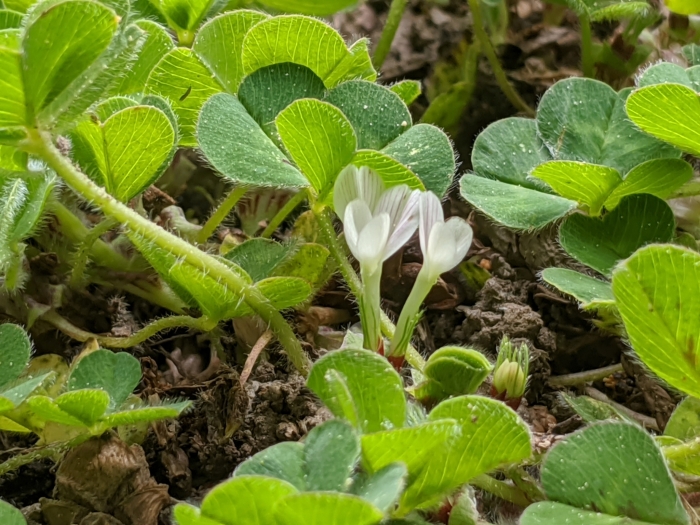Subterranean Clover
(Trifolium subterraneum)
Subterranean Clover (Trifolium subterraneum)
/
/

John A Haskins
CC BY 4.0
Image By:
John A Haskins
Recorded By:
Copyright:
CC BY 4.0
Copyright Notice:
Photo by: John A Haskins | License Type: CC BY 4.0 | License URL: http://creativecommons.org/licenses/by/4.0/ | Rights Holder: John A Haskins | Publisher: iNaturalist | Date Created: 2020-05-01T14:02:42-07:00 |

























Estimated Native Range
Summary
Trifolium subterraneum, commonly known as subterranean clover, is an annual herb native to the Mediterranean region, including Europe, Southwest Asia, Northwest Africa, and Macaronesia. It is adapted to a variety of habitats, including grasslands, open woodlands, and fields. This plant typically grows to a height of 4-8 inches (10-20 cm) and has a sprawling habit. Subterranean clover is notable for its trifoliate leaves and small, white to pinkish flowers that appear in spring. Its unique reproductive strategy, geocarpy, involves burying its seeds underground, which protects them from predation and aids in soil stabilization.
Subterranean clover is valued for its ability to improve soil fertility through nitrogen fixation and its resilience in poor-quality soils, making it an excellent cover crop and green manure. It is widely cultivated for animal fodder, particularly in regions like Australia, California, and Texas. While it has low-nectar flowers that are less attractive to bees, it can still support a range of beneficial insects. Care should be taken when planting subterranean clover, as it can become invasive outside its native range. It prefers full sun to partial shade and tolerates a range of soil types, though it thrives in well-drained soils.CC BY-SA 4.0
Subterranean clover is valued for its ability to improve soil fertility through nitrogen fixation and its resilience in poor-quality soils, making it an excellent cover crop and green manure. It is widely cultivated for animal fodder, particularly in regions like Australia, California, and Texas. While it has low-nectar flowers that are less attractive to bees, it can still support a range of beneficial insects. Care should be taken when planting subterranean clover, as it can become invasive outside its native range. It prefers full sun to partial shade and tolerates a range of soil types, though it thrives in well-drained soils.CC BY-SA 4.0
Plant Description
- Plant Type: Herb
- Height: 0.1-0.5 feet
- Width: 0.5-1 feet
- Growth Rate: Rapid
- Flower Color: White
- Flowering Season: Winter
- Leaf Retention:
Growth Requirements
- Sun: Full Sun, Part Shade
- Water: Medium
- Drainage: Fast, Medium
Common Uses
Bee Garden, Groundcover, Low Maintenance
Natural Habitat
Native to grasslands, open woodlands, and fields in the Mediterranean region
Other Names
Common Names: Dutch Clover, Sub Clover
Scientific Names: , Trifolium subterraneum, Calycomorphum subterraneum, Trifolium brachycalycinum, Trifolium oxaloides, Trifolium oxaloides, Trifolium subterraneum subsp. longipes, Trifolium subterraneum var. genuinum, Trifolium subterraneum var. typicum, Triphylloides comosa,
GBIF Accepted Name: